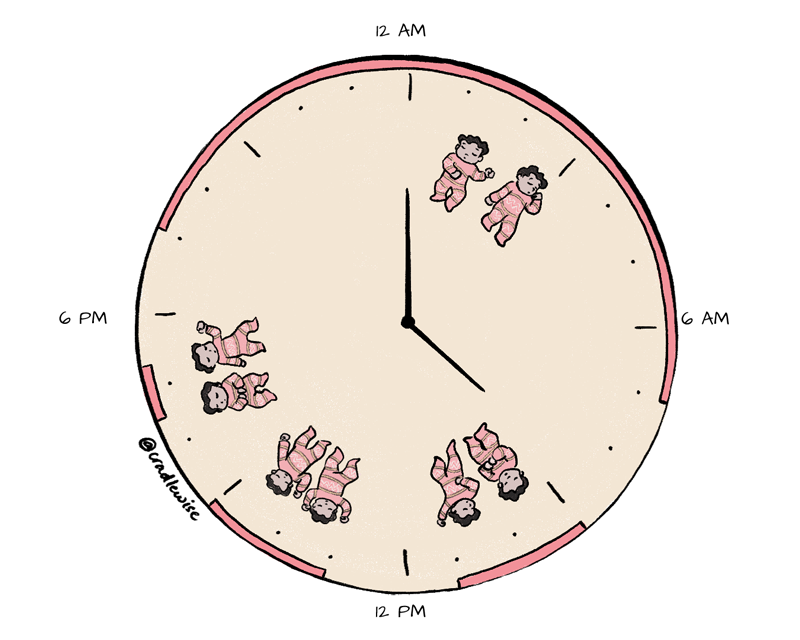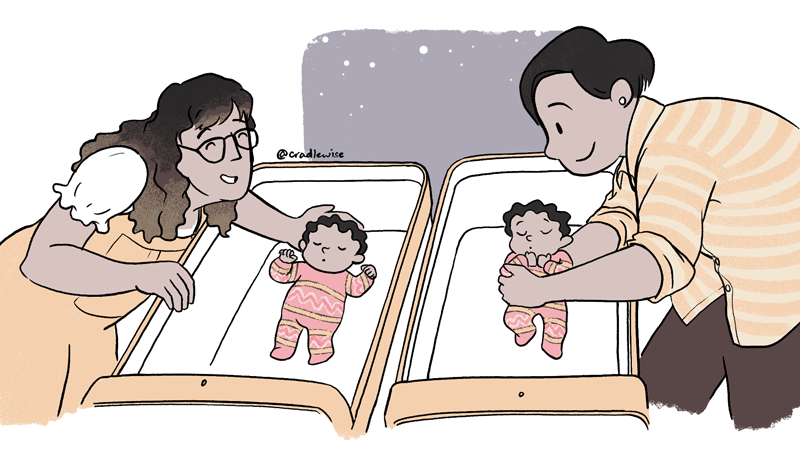
Night sleep
9-10 hours

Daytime naps
4-5 hours

Total sleep
13-15 hours
Now that your baby has been in your life for a whopping third of a year (wow!), we bet that some things, such as changing diapers, feeding, and even getting out the door in a reasonable amount of time, are starting to feel easy. However, you should always be prepared for your child to throw you a curveball or two. (Ah, parenting.)
Around this time, you may notice your baby’s sleep stabilizing, with regular naps and longer overnight chunks of sleep, only to become thrown off again with more night wakings. Read on to learn why this happens and more research-based info about the 4-month milestone.
4-month-old baby milestones for sleep
The 4-month-old milestones that are important during this time relate to both overnight sleep and napping.
At 4-months-old your little one might begin to take a consistent midmorning nap, and within a few weeks, a second midday nap as well.
Many babies will also still need a short third nap to help them bridge the gap until bedtime.
Another lovely development is that four-month-olds sleep longer stretches overnight. If you’re wondering when your baby is going to “sleep through the night,” it’s important to temper your expectations—social media can make it seem (incorrectly) that every baby is sleeping 12 hours straight by the time they’re three months old.
A study in Pediatrics found that 58 percent of children were sleeping from 12 a.m. to 5 a.m. by age three months, and that number jumped to 70 percent by age four months. But in terms of sleeping closely to when adults sleep (10 p.m. to 6 a.m.), less than 50 percent of 4-month-olds did.
Still, try to be optimistic. We’re betting that whatever amount of sleep your family is getting now, it feels way more consistent than during month one.

Cradlewise Smart Crib
Smarter Sleep for Your Baby
An award-winning crib—loved by parents, approved by experts.
0 to 24 months of use
Automatic soothing
Built-in video & sound machine
AI-powered sleep insights
Customizable soundtracks
Get 2 extra hours of sleep nightly
What’s going on in your baby’s brain?

Some good news: Four months is when circadian rhythms start solidifying, which is why babies can often stay asleep for longer stretches. However, some infants continue to wake up like 2-month-olds.
This could be a sign of the 4-month sleep regression, which can happen as your baby starts sleeping more like an adult and moving from light to deep sleep. They’re also getting excited by all their new skills (babbling, rocking, rolling), becoming more attuned to their surroundings, and, of course, missing their favorite people when it’s time to sleep. The good news is that trouble sleeping around the 4-month mark is a normal sign of development.
In the wee hours of the morning, you may find yourself wondering, how long does the 4-month sleep regression last? It could be anywhere from two to four weeks, and you will likely see additional temporary regressions when your child is ill, teething, or in a new situation, like traveling to a new place.

Crib Notes
You can always give your little one some extra TLC by increasing the ‘Sensitivity’ of your Cradlewise. Crib ‘Sensitivity’ determines how quickly and often your Cradlewise responds to sleep disturbances.
How much should a 4-month-old sleep?

At 4-months old, your baby’s total hours of sleep will decrease to 13 – 15 hours. Each wake window will last for 1.5 to 2 hours and naps for roughly 3 to 4 hours.
Because the balance is shifting toward a longer stretch of overnight sleep, you may also need to shorten or even get rid of late afternoon naps in favor of an earlier bedtime.
You may also notice that their morning nap is getting a little shorter because they are getting better rest overnight. During the day, the two-hour wake window is still a good guideline.
You might be curious about how long a 4-month-old should nap, and that answer is going to vary with every baby. Naps should be at least 90 minutes (or two sleep cycles) to allow for proper rest, but if your baby is taking three naps, that final one might be closer to 45 minutes.
If your baby is waking up after 45 minutes, Cradlewise can help soothe them back to sleep.
Sample 4-month-old sleep schedule
As always, keep in mind that these are just guidelines, and your baby’s needs may be different, especially if they were born prematurely. Watch them carefully and aim to put them down for naps or bedtime when they are showing signs of being tired, like avoiding eye contact or rubbing their eyes, but haven’t gotten full-on fussy.


4-month-old feeding tips
By 4 months, your baby has maybe doubled their birth weight. But even if they haven’t, as long as they are following their original curve and meeting milestones, your pediatrician will likely not be concerned.
To ensure that your baby is getting enough nourishment, the same indicators continue to apply: They should be making at least six diapers with pale, mild-smelling urine and seem comfortable between feedings. Contact your pediatrician between well visits if you have concerns about how much your child is eating.
- How often should a 4-month-old eat: During the day, your baby will still eat every 2 to 3 hours, but they may be able to sleep overnight from 6 to 8 hours without needing a feed.
- How much should a 4-month-old eat: By 4 months, you can expect your baby to take 4 to 6 ounces of breast milk or formula each time they eat.
Although some parents might already be asking, “Can I give my four-month-old baby food?” especially if their babies have started to get teeth, the American Academy of Pediatrics recommends waiting to start solid food until around six months old.
- Tip: As your 4-month-old gets more excited about the world, they may get easily distracted during feedings. You may have more success feeding them in a quiet spot, like a park bench amid the trees, rather than one in full view of the playground.
The 4th month is often a time of a lot of events that might disrupt your baby’s sleep cycles—from regressions to the 4-month shots like diphtheria, tetanus, polio (IPV), etc.
You can always give your little one some extra TLC by increasing the ‘Sensitivity Setting’ of the crib. Crib Sensitivity determines how quickly and often your Cradlewise responds to sleep disturbances.
How to help support your baby’s sleep during the fourth month

Prioritize naps during regressions.
Prioritize naps during regressions.
If your baby is showing 4-month sleep regression signs and waking up frequently overnight, it’s especially important that they stay on a consistent nap schedule. You might also notice that their naps become shorter, but try to catch the drowsy window when you can. And during these stressful periods, try to make sure that parents and caregivers are getting proper rest, even if it means they need their daytime naps.
When is the right time to start sleep training your baby if you decide it’s right for your family?
When is the right time to start sleep training your baby if you decide it’s right for your family?
Some parents may try around the 4-month mark, which experts generally say is the earliest you should begin, while others prefer to wait until 6 months. You know your baby and the needs of your family best, so follow your gut when it comes to this one. If you do decide to sleep train, you’ll be able to adjust Cradlewise to help you each step of the way.
Work on falling asleep without help.
Work on falling asleep without help.
The morning nap, especially if it is happening at a predictable time and your baby is well-rested from the night before, is a great time for your baby to practice getting themself to sleep without needing nursing, bottle-feeding, bouncing or another type of soothing. Think of it as an important investment in helping them develop the skill of getting themselves to sleep independently, which they’ll use their entire life. Once your baby is starting to look drowsy, put them in their Cradlewise and leave the room. You can give them anywhere from 5 to 20 minutes to see if they fall asleep, but if they don’t, you can always try again another day.
Plan for exercise.
Plan for exercise.
Your kiddo isn’t ready for spin class just yet, but movement during the day as well as the chance to work on skills like sitting with support and rolling just might help them snooze better at night. 4-month-old baby activities might include spending time on their tummy-time mat, working on mini push-ups, looking in their mirror, or practicing their reaching and grasping skills with soft toys.
More posts you might like:
- 5-month-old baby sleep guide
- 6-month-old baby sleep guide
- 7-month-old baby sleep guide
- 8-month-old baby sleep guide
- 9-month-old baby sleep guide
- 10-month-old baby sleep guide
- 11-month-old baby sleep guide
- 12-month old baby sleep guide
Sources:
- Midmorning and midday naps appear. 2021. Healthy Sleep Habits, Happy Child, Fifth Edition.
- When do children sleep through the night? 2010. Pediatrics. Sleeping Through the Night: The Consolidation of Self-Regulated Sleep Across the First Year of Life
- Fussiness mostly resolves by four months. 2021. Healthy Sleep Habits, Happy Child, Fifth Edition.
- Newborn reflexes begin to fade during the second and third month. 2019. American Academy of Pediatrics: Caring for Your Baby and Young Child from Birth to Age Five, Seventh Edition.
- Circadian rhythms in 10- to 12 -week olds. 2017. Nature of Science and Sleep. Infant sleep and its relation with cognition and growth: a narrative review
- Total hours of sleep for four-month-olds. Stanford Children’s Health. Infant Sleep.
- Nap strategies for four-month-olds. 2021. Healthy Sleep Habits, Happy Child, Fifth Edition.
- Babies doubling birth weight. 2019. Nemours Kids Health. Your Baby’s Growth: Four Months.
- Baby feeding frequency. 2022. HealthyChildren.org. How often and how much should your baby eat?
- When to introduce solids. 2021. Centers for Disease Control. When, What, and How to Introduce Solid Foods.
- Helping baby fall asleep independently. 2021. Healthy Sleep Habits, Happy Child, Fifth Edition.
You may also like





